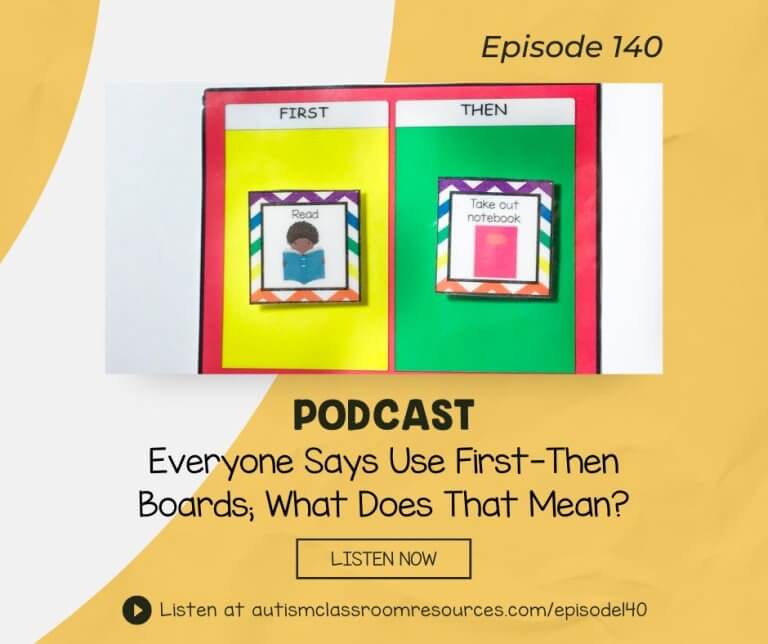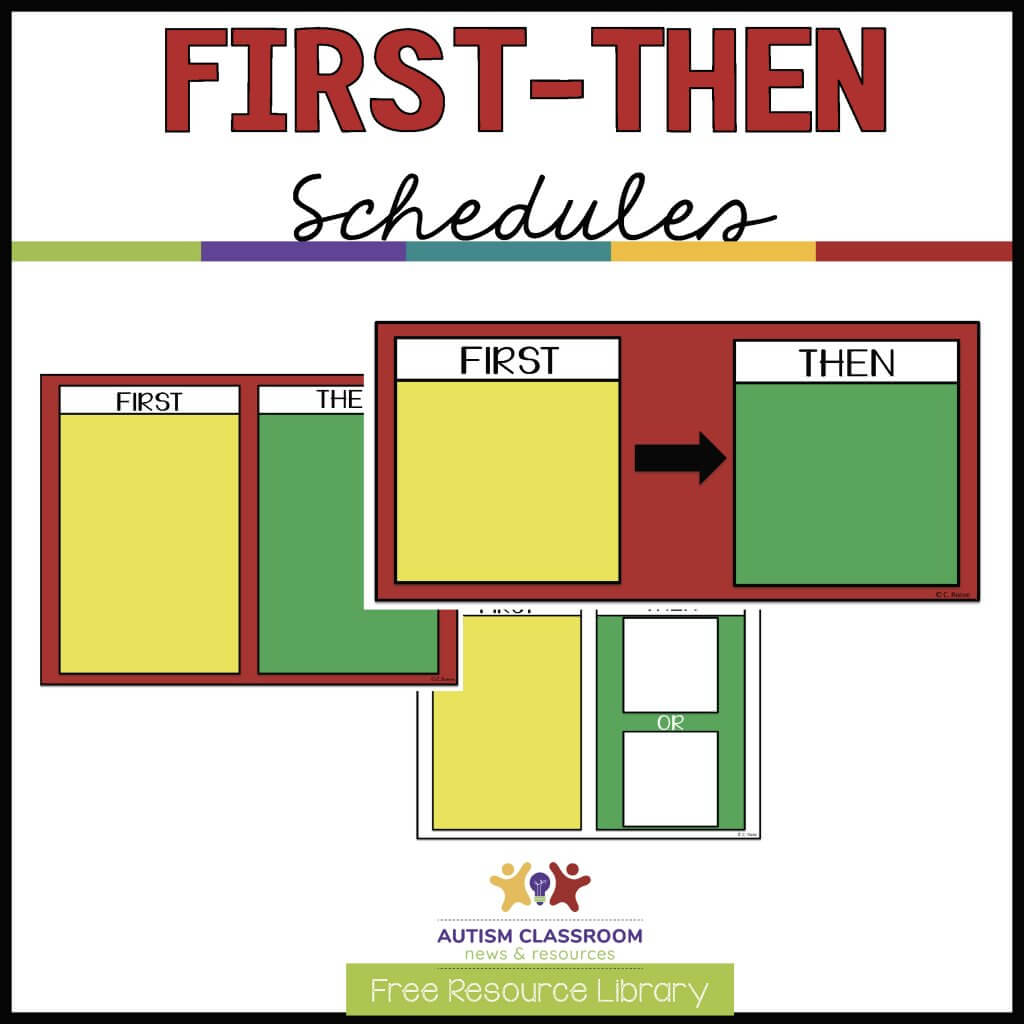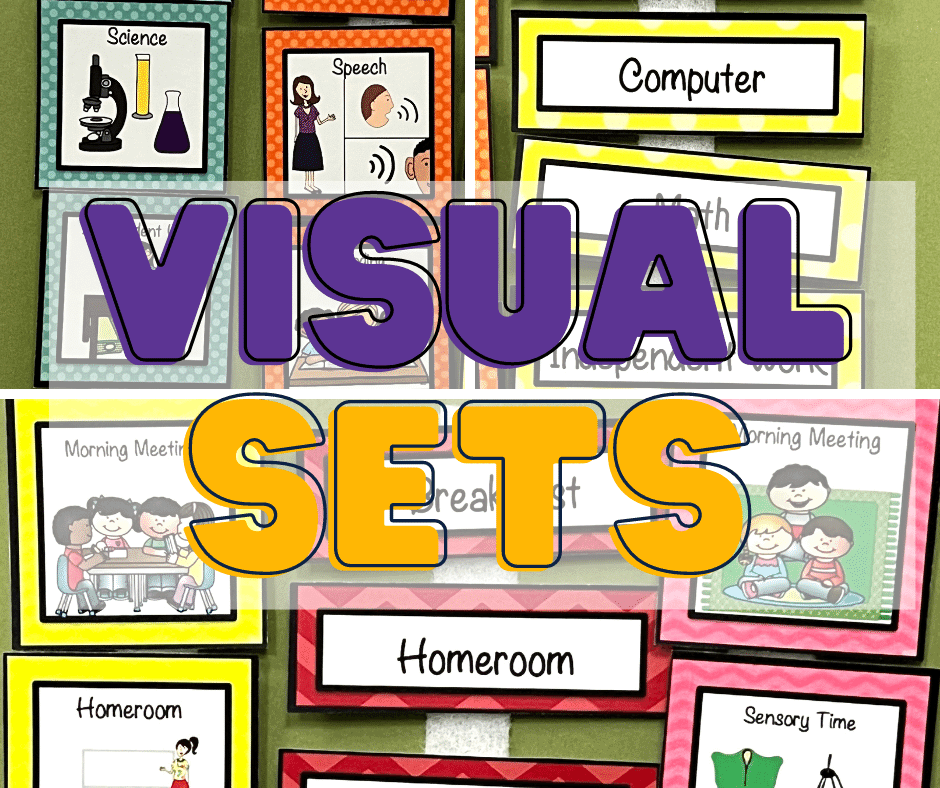Welcome to the Autism Classroom Resources Podcast, the podcast for special educators who are looking for personal and professional development.
Christine Reeve: I’m your host, Dr. Christine Reeve. For more than 20 years, I’ve worn lots of hats in special education but my real love is helping special educators like you. This podcast will give you tips and ways to implement research-based practices in a practical way in your classroom to make your job easier and more effective.
Welcome back to the Autism Classroom Resources Podcast. I am glad that you are here. This is our last segment in our mini series on visual schedules. Last week in Episode 139, I talked about the broad schedule, the class schedule, and the group schedule and why that is an important one to use.
Today I’m going to do a complete 180, I’m going to talk about the little teeny-tiny schedule that we often use. I had someone ask me a question not too long ago about when to use a first/then and when to use a regular schedule. I thought I’d just talk a little bit about first/then schedules, how we use them, when we use them. I also have a freebie for you on the website for this episode. I will talk about that a little bit later. Let’s get started.
First/then schedules are some of the simplest types of visual supports that we use with students with autism and all sorts of other students with special needs. Essentially, what the first/then schedule does is it presents what we need to do now the first and what we will do next, the then, sometimes they’re even called first/next. It can be done with pictures, it can be done with objects, it can be done in writing. It can be done using apps.
We use them in a lot of different forms, but we also use them for different functions in our classroom. I thought I’d talk for a moment about some of those functions. Most often when people think of first/then, I think they’re thinking about them in terms of behavioral support. We think that a student or we know that a student is going to have a hard time with something that we want them to do so we present it to them in that we want them to do this and the first and the thing that they get as a reinforcer in the then.
We’re using a preferred activity or item as a reinforcer for the thing that they don’t want to do. The idea is we’re showing a preferred activity or a possible reinforcer to motivate them to complete that thing that they don’t want to do. We also often use this just as a straight first/then board, we often print a bunch of them, keep them around the classroom. We’re using what’s known as the Premack Principle, which is also known as grandma’s rule, which is if you do this, then this will happen.
Then you get something that you like so it’s if you eat all your vegetables, you get dessert, but essentially the Premack Principle, the scientific definition, is that a low probability behavior can be reinforced by a high probability behavior. For our students doing what we want them to do, maybe the low probability, and getting to play on the iPad might be a high probability. Ultimately, in this function, we want to use them proactively before there is a problem.
When a student refuses to complete a task, we do sometimes use it. But if we’re not using it proactively, if we’re using it in reaction to a refusal, then we run the risk of ending up reinforcing that refusal behavior by pulling out the reinforcer in the first/then board. If refusing to do something means that I get the opportunity to earn something and just doing it doesn’t, then you might be reinforcing that negative behavior.
You want to be really careful about that. You really want to think about it ahead of time if you know that something’s going to be difficult or that a student is likely not to do it, because in the past, he’s not done it, then it is a useful tool to pull out. A first/then board can be a very powerful tool to help the students complete a task that they often resist.
Early learners may not like to clean up after playtime in a preschool. But if we schedule a snack after play, then there’s an incentive to get through it to the thing that they are going to enjoy. This is just presenting it on a first/then schedule to show them the first activity cleaning up will be followed by the next activity, the snack. It’s using that Premack Principle in our scheduling, not just in pulling them out when we think that we’re going to need them. But you can also use a first/then for some students as a daily schedule.
I want to tell you a story. I had a student who really struggled with his daily schedule. He would check it but he didn’t really understand where it went. It just became like multiple transitions. Transitioning from work over to the wall was a transition, the wall to the next activity was a transition. They were just a lot of transitions for him and he was really, really struggling.
As we realized that, we started to think about how we might break his schedule down. We knew he could match so the pictures were appropriate for him. Essentially, it worked out that he was checking his schedule and became an antecedent for problem behavior. That’s one of the reasons we were really trying to address it.
The second day that we worked with him after we observed that, we decided to take his schedule and put it in a first/then form. We took the schedule itself, the pictures, and we put them on the outside of a notebook as first/then. We just put tape down the middle. We labeled it first/then, put two pieces of Velcro on it, and we put the events of his day on sheets in order inside the notebook. We didn’t do it because we wanted him to check it but so that it would be easy for us to grab the next or the next first.
That allowed the staff to quickly switch out the visuals for each transition. We started with a scheduled activity being followed by a reinforcer, first work with the teacher, then you get played out. Over time he was actually able to manage the schedule with just the events of the day without having those extra reinforcers put in there.
He was eventually able to even go into the schedule and change his own schedule, and that greatly increased his independence throughout the day, and it reduced the challenging behaviors. When we first gave him the notebook, the look of comprehension that came over his face was so amazing to see. It seemed like he was saying, “Oh, I get it now.” His behavior got significantly better very quickly using that schedule as opposed to the full day one that we had on the wall.
That really allowed him to begin to understand it. Later we’ll go back to a bigger schedule. But for right now, that eased him through his day. Now, I do have one word of caution with this. That is, never start an entire class of students on first/then notebook schedules at the same time if they don’t know how to be responsible for them and have not used them before.
We also tried that at one time in a classroom, we really felt that there were too many transitions for the students to go back and forth to the schedule so we wanted to be able to have the schedule where they were. We put everybody on a notebook schedule with the first/then on the front. What happened was just short of disaster, because we spent the whole day never being able to find the students’ schedules. They just were never where they were supposed to be because the students didn’t know how to be responsible for them.
We didn’t have the hands to be responsible for all the students’ schedules at the same time. The next day we broke it down and we just started two of the students on the first/then. The other kids we just brought visuals to when it was time to transition and we slowly worked our way through the class to build up to using more independent types of schedules.
Now, it’s important to recognize that when you’re using a first/then schedule, it really doesn’t have to be pretty. Now if your students are using pictures, symbols, or photos, you will probably need those depicting the daily activities. The steps in the reinforcers have to be there but some students just need the structure and some of them are readers, and in that case, you can start making first/then on the fly and that is awesome.
Because you just draw it out on a piece of paper or a post-it note. I’ve sometimes done it on two post-it notes, even for kids who could understand what I was telling them but didn’t typically do reading. I didn’t need to have pictures, I just did, “First, you do the thing that’s on the pink and then you do the thing that’s on the yellow.” But you can also use a dry erase board. You can just pull it out from scratch, a piece of paper, and make your first/then so you can make them anywhere. They don’t have to be any special thing.
When you’re presenting the first/then schedule, like with most tools, you want to try to minimize your verbal directions. Typically the teacher would give the verbal instruction one time, then you would point to the visual to redirect the student and you would use nonverbal redirection where you’ve reduced your language so it’s not as overwhelming for the student and it helps ease anxieties. It also allows you to fade the prompts out more easily.
It also has the byproduct effect of having a student not be able to argue with the schedule. I’m just saying a fact of life, schedule first/then. First, gotta do this. I’ve never even had my really, really bright kids figure out that I made the schedule so I am the one that’s telling them to do that. Depending on the situation, if the students will go and respond, they typically will respond in a few minutes. If not, then maybe we need to look at either stronger reinforcers or other options for addressing those challenging behaviors.
But for a lot of students, that visual first/then can be a really important step in understanding the classroom structure and in following routines. I have a free download for you on the webpage with this episode, go to autismclassroomresources.com/episode140. I have a really extended first/then set of schedules. They include large, small, black and white, colored, all different kinds.
You can grab a free first/then from the Resource Library, and you’ll get additional tips from me in the future like this one and probably I’ll be able to show you how I use little photo boxes to manage all the pieces of the first/then at times. I’ve got that coming as well. I hope that that gives you some good ideas. A first/then schedule is something that I always think is a critical piece that we need to have multiple of. This gives you lots of opportunities to just print and laminate what you need.
If you are looking for more tips and support for your special ed classroom and you want to feel back in control again of everything that’s going on, come to the Special Educator Academy at specialeducatoracademy.com and get a seven-day free trial where we have tons of little resources like this but also lots and lots of training, community, and people who know exactly what it’s like to be in your classroom. Hopefully I will see you there. I will be back next week with a new topic. I hope that you will join me then. Have an amazing week.










